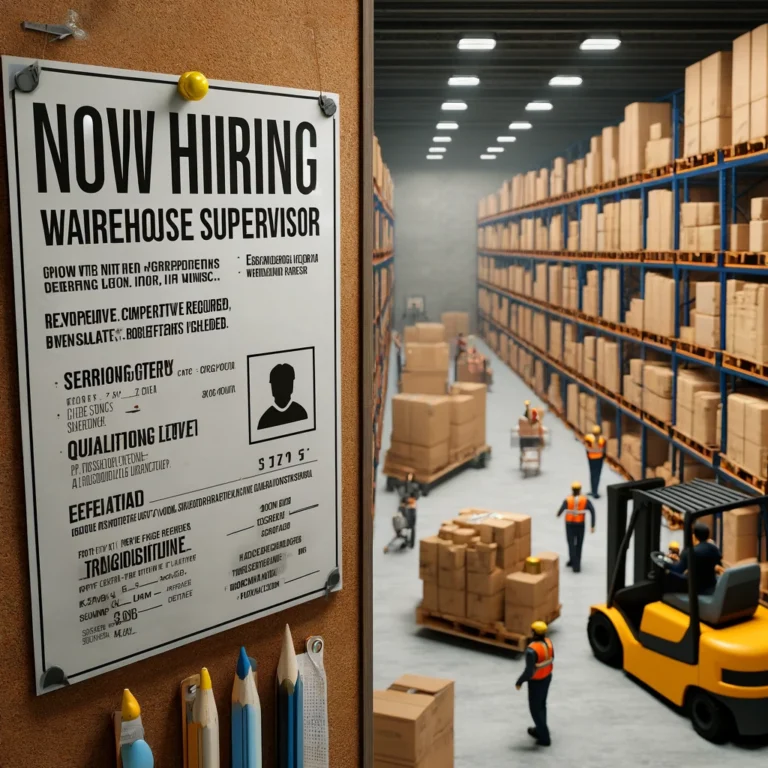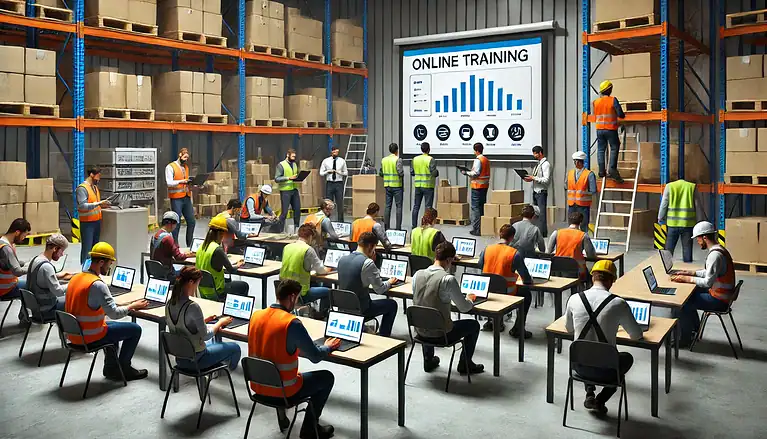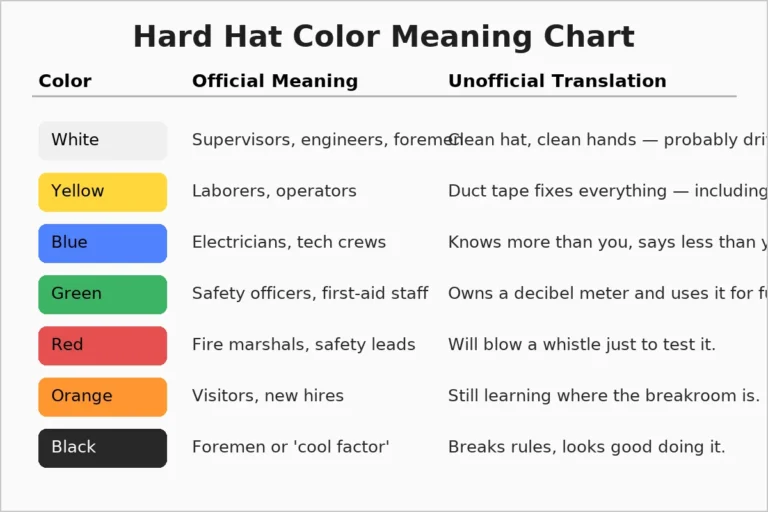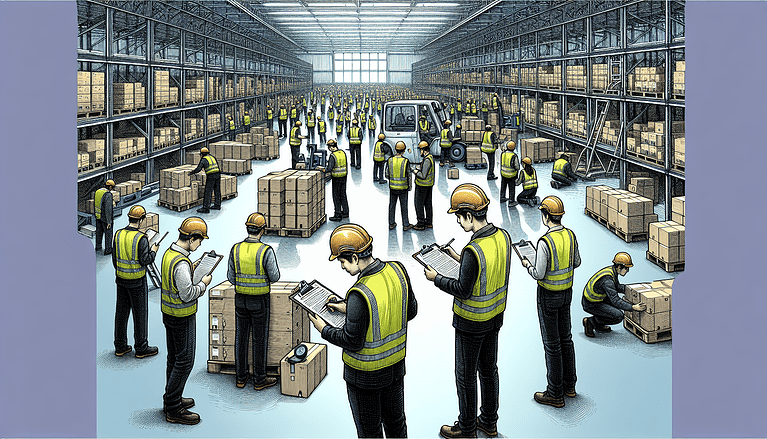Essential Duties of a Warehouse Safety Supervisor in 2025
The role of the warehouse safety supervisor is central to not just adhering to regulations but actively safeguarding the workplace. Their commitment fosters an atmosphere focused on vigilance and preventive actions against hazards.
Table of Contents

This piece delves into their responsibilities, from evaluating potential risks to imparting safety training among staff members. It highlights key competencies that characterize a successful supervisor in this pivotal leadership role.
Continuing reading will offer valuable knowledge for creating a robust and secure work setting for those aspiring to improve existing safety protocols or pursue this essential position within the warehouse.
Key Takeaways
- A warehouse safety supervisor creates and maintains a safety culture, ensures legal and industry compliance, and effectively manages risks through educational programs and regular audits.
- Essential skills for warehouse safety supervisors include effective communication, problem-solving, attention to detail, and providing continuous training to workers on safety protocols and emergency responses.
- Implementing safety measures like regular hazard assessments, safety inspections, and the provision of personal protective equipment are critical for preventing workplace accidents and ensuring a safe workplace.
The Role of a Warehouse Safety Supervisor

A warehouse safety supervisor is the linchpin of a secure work environment, serving as the first line of defense in reducing workplace injuries. Under their watchful eye, employees can report hazardous conditions without fear of retribution, fostering a culture of openness that is vital for maintaining safety.
This role goes beyond mere oversight. It is about creating an environment where safety is intricately woven into the fabric of daily operations, a culture where everyone is a custodian of their and their colleagues’ safety.
Occupational Health and Safety
In the dynamic environment of warehouse operations, emphasis is placed on averting injuries among employees and adeptly controlling safety risks. Occupational health and occupational safety are key disciplines in this context.
The primary objective within a warehouse milieu is to proactively prevent accidents from occurring rather than merely reacting to them after they occur.
Implementing such a strategy requires an in-depth knowledge of possible workplace hazards, careful planning, and unwavering implementation efforts. It’s about adopting a broad-spectrum approach that includes:
- utilizing personal protective equipment
- ensuring safe operation of machinery
- implementing fire prevention protocols
- establishing proactive emergency response procedures
Essentially, it’s crafting an all-encompassing plan to safeguard the well-being of workers operating within warehousing facilities consistently across every shift.
Safety Responsibilities

Creating a solid safety culture in the workplace is no small feat. It demands an enduring dedication from leadership, well-defined policies and procedures, and a steadfast commitment to ongoing improvement.
Educational programs tailored for employees and management are crucial to any extensive safety and wellness strategy. Such initiatives bolster not only the robustness of the safety culture but also broadly enhance employee welfare.
Nurturing open communication channels alongside regular engagements such as safety meetings plays a vital role in reinforcing the ethos of workplace safety. This enhancement can notably elevate the company’s public standing.
The proactive steps towards recognizing potential hazards — assessing them diligently and arranging them by their level or urgency — are pivotal functions within an effective safety program framework.
Conducting thorough investigations into work-related incidents, including injuries, illnesses, or near-misses, stands paramount for illuminating obscured risks while pinpointing avenues for preventative interventions.
In essence, warehouse safety supervisors are responsible for reliably upholding safe conditions across all aspects of employment spaces, ensuring healthful environments where every employee can safely perform their duties.
Essential Skills for Warehouse Safety Supervisors

In a warehouse’s ever-evolving environment, a safety supervisor’s ability to execute their responsibilities successfully requires specific skills. Effective communication is at the top of this skill set, and it includes delivering safety directives with clarity, efficiently compiling reports, or meticulously documenting safety procedures.
Problem-solving abilities are indispensable in such settings, so a supervisor must be adept at swiftly pinpointing and addressing potential risks promptly. Keen attention to detail also plays an integral role.
It allows for precise detection of hazards, proper record-keeping, and adherence to various safety regulations, which cumulatively foster increased workplace efficiency and enhanced protection against accidents.
Training Employees
The key duties of a warehouse safety supervisor include instilling in team members an understanding of essential health and safety matters and fostering an atmosphere that prioritizes safe practices.
This encompasses delivering training focused on correctly using equipment and adherence to established safety procedures. The responsibility extends beyond initial orientation. It entails ongoing instruction to keep staff current with evolving best practices in workplace safety.
Through consistent education, workers develop the competence to identify potential risks, adhere strictly to safeguarding protocols, and tackle emergencies effectively. Such preparedness enables them to look after their well-being and that of their peers.
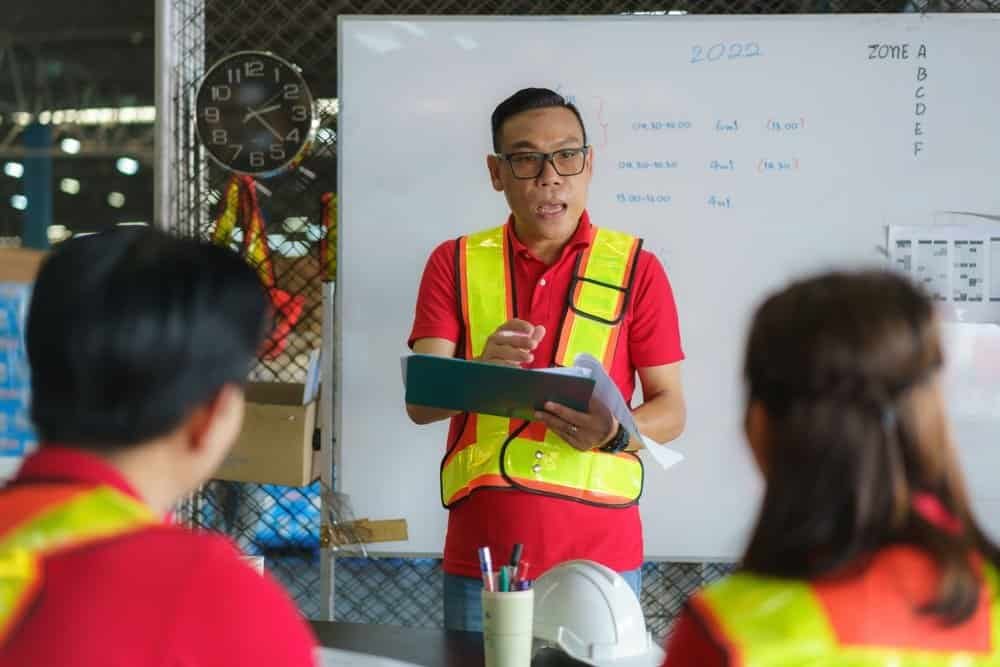
In a culture where everyone is vigilant about preserving a secure working environment, employee engagement surges along with their ability to handle machinery or tools skillfully—and reaffirms their dedication to upholding stringent standards for occupational health and protection against accidents.
Monitoring Daily Operations
The duties of a warehouse safety supervisor encompass the following:
- Instructing and informing employees about safe work procedures
- Overseeing day-to-day activities to guarantee that safety protocols are adhered to
- Implementing adherence to secure working practices
- Addressing any unsafe situations that arise
- Investigating incidents after they occur in the workplace
Those responsible for supervising warehouses shoulder multiple tasks, such as:
- Carrying out frequent evaluations of the premises to identify both existing and potential hazards
- Taking preventative steps with an aim at forestalling accidents before they happen
Managing how goods are received and sent off, ensuring their quality remains high. Striving for ongoing enhancements within warehouse operational methods.
Vigilance is maintained during daily operations to preserve outstanding security levels and provide a protected setting for all staff members.
Implementing Safety Measures in the Workplace
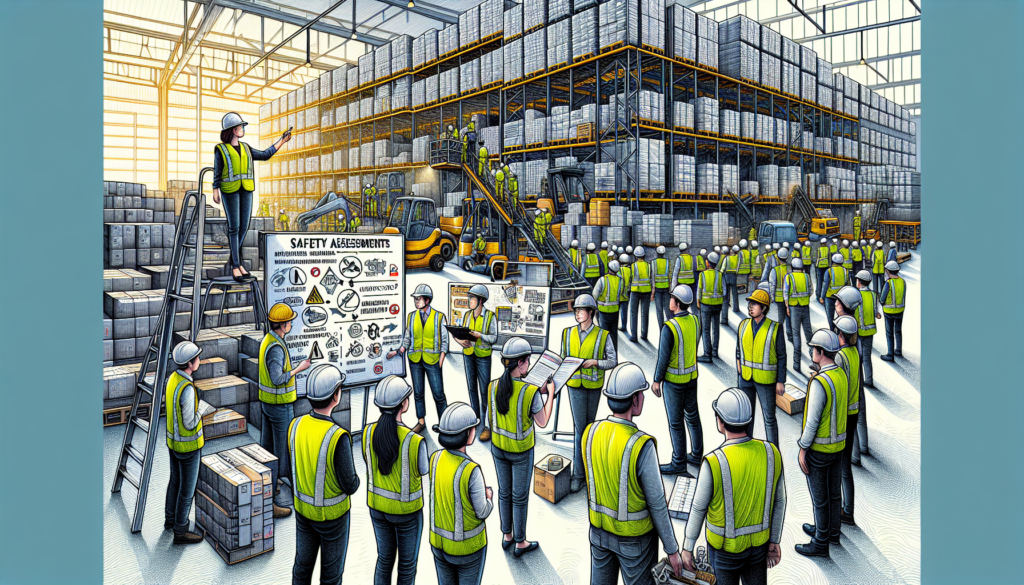
Supervisors dedicated to ensuring safety in the warehouse prioritize various protective measures to maintain a secure environment for workers. They carry out frequent evaluations and inspections focused on safety, adhering closely to the guidelines established by OSHA.
Through these systematic checks, they can spot impending dangers early on and take appropriate action to reduce such risks.
Supervisors provide essential personal protective equipment to shield staff members from hazards, including hard hats, gloves, and safety glasses—crucial barriers against injury.
Strategies designed to prevent accidents are strictly enforced. This includes routine examination of machinery as well as rigorous compliance with procedures involving lockout/tagout when dealing with powered equipment—all part of their effort to bolster workplace protection.
Personal Protective Equipment (PPE)
Personal protective equipment (PPE) is paramount in ensuring the safety of workers within a warehouse environment. Various forms of PPE that are essential include:
- Safety vests with high visibility
- Lumbar support belts for tasks involving heavy lifting
- Footwear reinforced with steel toes
- Noise-canceling earmuffs
- Protective goggles
- Industrial safety helmets
This equipment acts as a defensive layer, shielding employees from potential dangers they may encounter.
Choosing appropriate PPE is imperative, as distinct positions and circumstances demand particular types of gear for adequate protection. Proper maintenance involves securely storing this gear when not utilized to avoid any deterioration or damage that could compromise its capacity to safeguard personnel effectively.
Disposing of old or unusable PPE must adhere strictly to environmental and safety regulations so it does not pose any risks to individuals handling waste or the ecosystem.
Accident Prevention Strategies

Within warehouse safety, preventing accidents rather than curing them later is always more beneficial. Regular safety audits are pivotal for detecting operational weaknesses, which can be improved to enhance workplace safety measures and reduce workers’ compensation claims. Effective accident prevention involves:
- Proper waste disposal
- Energy consumption reduction
- Safe handling, storage, and disposal of hazardous chemicals
- Use of suitable personal protective equipment
These measures help to manage workplace hazards and ensure a safe working environment.
Another effective strategy is to implement a hazard categorization system. By prioritizing risks based on severity and likelihood, safety supervisors can develop more targeted accident prevention strategies, ensuring that the most significant risks are addressed first.
Benefits of Effective Warehouse Safety Supervision

Efficiently overseeing safety within a warehouse can lead to substantial advantages. It remarkably reduces workplace accidents, safeguarding employees while facilitating uninterrupted operations. Beyond mere protection, active safety management enables companies to:
- Diminish expenses linked to workplace incidents, like medical bills and legal costs
- Bolster employee morale and satisfaction with their jobs
- Enhance overall productivity and operational efficiency
- Comply consistently with established safety standards
- Safeguard the company’s public image and branding
Investing in rigorous supervision for warehouse safety is thus an intelligent move that positively affects staff well-being and corporate achievement.
Cultivating a robust culture of safety through meticulous oversight generates more contented and confident workers.
The assurance provided by feeling secure under such care often translates into greater work output, increased commitment from staff members, and stronger fidelity to the enterprise—factors that collectively propel the firm toward sustained success.
Reduced Workers’ Compensation Claims
A notable financial benefit of effective warehouse safety supervision is decreased compensation claims. Companies enforcing OSHA-compliant safety programs are statistically shown to have fewer workplace accidents, enhancing employee productivity and reducing workers’ compensation costs.
Comprehensive safety programs that reduce the frequency and severity of workplace injuries and illnesses can achieve substantial savings in workers’ compensation.
Cultivating a strong safety culture within the workplace leads to a decrease in overall accident rates, contributing to fewer workers’ compensation claims.
Implementing stringent warehouse safety protocols for employees is crucial in reducing accidents and lowering the financial burden of workers’ compensation claims.
Enhanced Company Reputation
How a company manages employee safety and health deeply impacts its standing within society and the industry.
When businesses prioritize these aspects, they are viewed as more credible by both customers and their industrial counterparts, giving them an advantage in the marketplace through an enhanced reputation tied to their strong record on safety management under warehouse conditions.
Becoming a Certified Safety Manager (CSM)

The Certified Safety Manager (CSM) designation can be demanding but rewarding. The process usually involves:
- Obtaining a bachelor’s degree in occupational health and safety,
- Gaining no less than five years of pertinent work experience,
- Completing specialized training, for example, NASP’s 40-hour foundational course
- Successfully scoring at least 80% on an online examination.
Once certified, Safety Managers operate autonomously to oversee programs, procedures, and safety-related policies. Their certification shows their expertise to prospective employers and regulatory bodies.
To preserve their CSM status, certificate holders must undertake additional training through a refresher course and pass a subsequent recertification test every three years.
Course Objectives
The Certified Safety Manager (CSM) program aims to equip safety supervisors in warehouses with essential skills and knowledge for successfully implementing and managing safety protocols.
CSMs are instrumental in reducing workplace accidents and injuries, which significantly affect productivity levels and the well-being of employees within a warehouse environment.
Safety supervisors who complete their CSM certification guarantee they possess up-to-date expertise on industry-specific regulations and best practices for maintaining safety during warehouse operations.
This course details recognizing hazards, evaluating risks, and devising appropriate safety strategies tailored specifically to be prepared in the warehousing sector.
It provides training in leadership techniques and efficient communication tactics designed to nurture an atmosphere that prioritizes safety among team members at a warehouse facility.
Topics Covered in CSM Training
The CSM curriculum provides essential knowledge for effectively managing safety in a warehouse environment. The program includes critical topics such as:
- Adherence to safety regulations and standards
- Recognizing hazards and evaluating risks
- Probing into incidents, along with their documentation
- Disseminating information about safety and organizing training programs
- Readiness for emergencies and appropriate reactions
The Supervisors’ Safety Development Program (SSDP) aims to ingrain safe practices into daily managerial responsibilities. It equips supervisors and managers with the necessary expertise. Upon finishing this course, participants must implement these skills within their workplace, including all pertinent reporting.
Through SSDP training, newly appointed or seasoned supervisors and managers are empowered as influential leaders promoting workplace safety. This transformative process reinforces and expands upon existing abilities related to well-being on the job.
Summary – Occupational Safety

Safety supervision within a warehouse is crucial for ensuring productivity and a secure working environment. A safety supervisor’s responsibilities are extensive and vital—they educate workers on safety practices and oversee daily operations to minimize employee compensation claims.
Obtaining CSM certification endows supervisors with essential skills and knowledge while confirming their proficiency to future employers and governing bodies. Looking ahead, it’s evident that those charged with supervising warehouse safety will remain key in maintaining global workplace safety standards and nurturing an overarching culture of security among staff.
Frequently Asked Questions (FAQs)
Q: What is the role of a Warehouse Safety Supervisor?
A Warehouse Safety Supervisor is tasked with fostering a safe working atmosphere, guaranteeing adherence to legal and industry-specific safety regulations, and motivating employees to confidently report any unsafe situations, knowing they will not face retribution.
Q: What skills are essential for a Warehouse Safety Supervisor?
A Warehouse Safety Supervisor must possess strong skills, such as efficient communication abilities, the aptitude for solving problems, meticulous attention to detail, proficiency in training others, and vigilant monitoring techniques. These capabilities are pivotal in upholding safety regulations within the warehouse. Such expertise is vital to secure and protect a warehouse environment for everyone working there.
Q: What safety measures do Warehouse Supervisors implement in the workplace?
In the warehouse, Safety Supervisors are tasked with maintaining a secure environment for employees by performing consistent safety inspections and hazard evaluations. They ensure that all workers have access to personal protective equipment while instituting strategies to prevent accidents, including daily equipment checks and enforcing lockout/tagout protocols.
Q: What are the benefits of effective warehouse safety supervision?
Ensuring robust safety oversight in a warehouse setting minimizes workplace accidents. This not only cuts down on expenses but also contributes to the contentment of employees and bolsters a company’s reputation, underlining its significance in fostering a secure and productive work atmosphere.
Q: How can one become a Certified Safety Manager (CSM)?
To attain the Certified Safety Manager (CSM) designation, candidates must hold a bachelor’s degree in occupational health and safety, possess no less than five years of pertinent work experience, and complete specialized training like the 40-hour foundational course NASP offers. Aspirants must successfully clear an online examination with an 80% or higher score.


